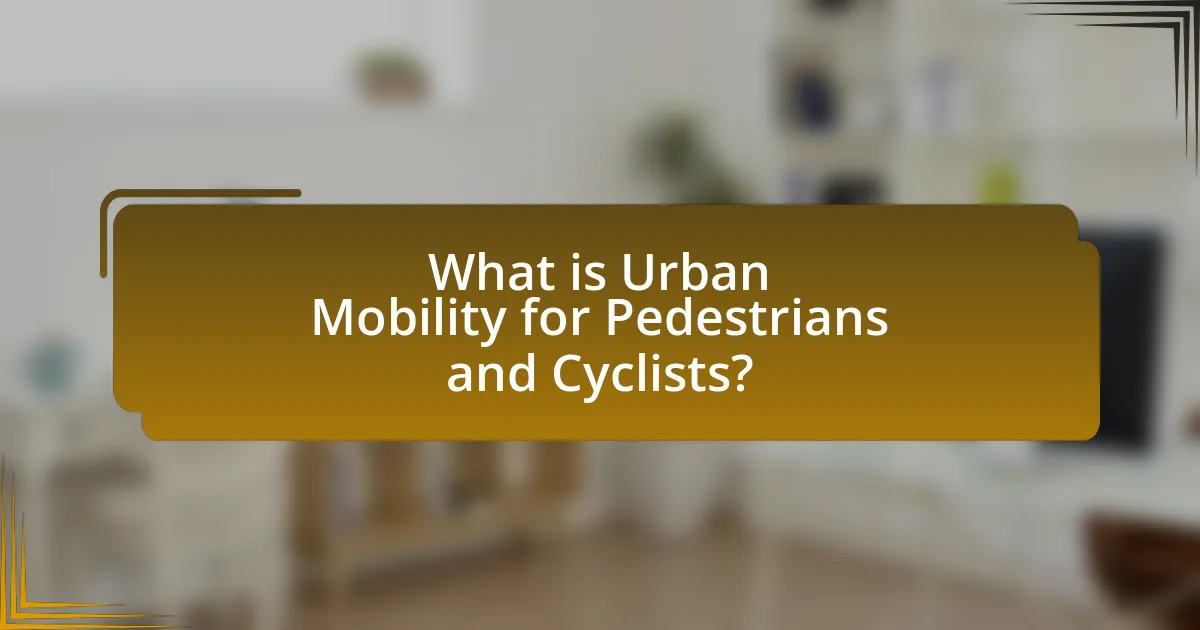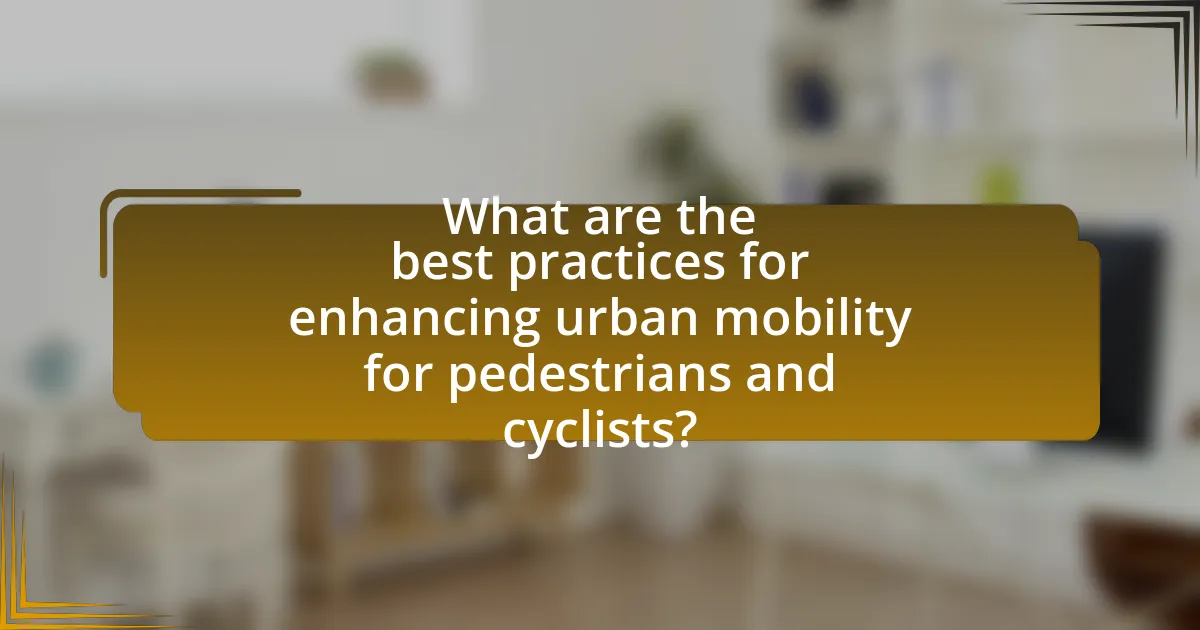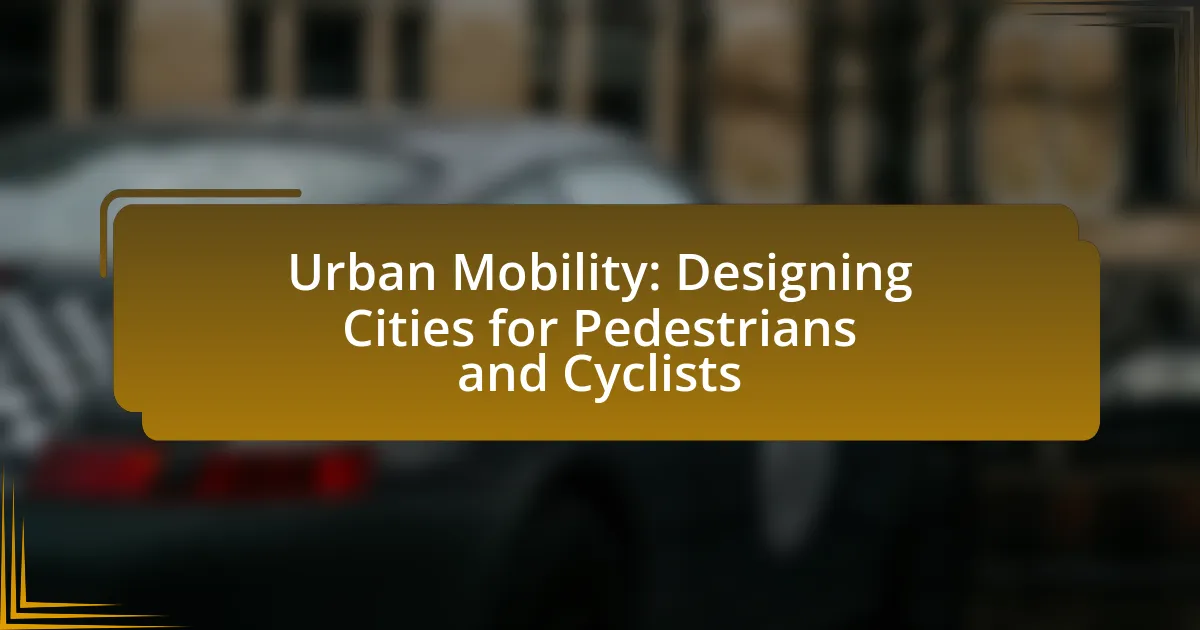Urban mobility for pedestrians and cyclists encompasses the systems and infrastructure that enable safe and efficient movement within urban areas, prioritizing non-motorized transport modes. This article explores the impact of urban mobility on city design, emphasizing principles such as safety, accessibility, connectivity, and comfort. It contrasts urban mobility strategies with traditional transportation planning, highlighting their significance for sustainable cities, public health, and environmental benefits. Additionally, the article addresses challenges in designing pedestrian and cyclist-friendly cities, innovative solutions, and best practices for enhancing urban mobility, including community engagement and partnerships with local organizations.

What is Urban Mobility for Pedestrians and Cyclists?
Urban mobility for pedestrians and cyclists refers to the systems and infrastructure that facilitate safe and efficient movement for individuals traveling on foot or by bicycle within urban environments. This concept emphasizes the importance of designing cities that prioritize non-motorized transport modes, which can lead to reduced traffic congestion, lower emissions, and improved public health. According to the World Health Organization, promoting walking and cycling can significantly enhance urban livability and sustainability, as these modes of transport contribute to lower air pollution levels and increased physical activity among residents.
How does urban mobility impact city design?
Urban mobility significantly influences city design by determining the layout, infrastructure, and accessibility of urban spaces. For instance, cities that prioritize public transportation and non-motorized transport, such as walking and cycling, often feature wider sidewalks, dedicated bike lanes, and efficient transit systems. Research indicates that cities like Copenhagen and Amsterdam, which emphasize cycling and pedestrian-friendly environments, have lower traffic congestion and higher quality of life metrics. This design approach not only enhances mobility but also promotes sustainability and reduces environmental impact, as evidenced by studies showing that increased cycling can lead to a decrease in greenhouse gas emissions.
What are the key principles of designing for pedestrians and cyclists?
The key principles of designing for pedestrians and cyclists include safety, accessibility, connectivity, and comfort. Safety is paramount; designs must minimize conflicts between motor vehicles and non-motorized users, often achieved through dedicated lanes and traffic calming measures. Accessibility ensures that pathways are usable by all individuals, including those with disabilities, which can be supported by features like curb cuts and clear signage. Connectivity involves creating a network of routes that link residential areas, commercial centers, and recreational spaces, facilitating seamless travel. Comfort focuses on providing adequate space, shade, and amenities such as benches and bike racks, enhancing the overall experience for users. These principles are supported by research indicating that cities implementing such designs see increased walking and cycling rates, contributing to healthier communities and reduced traffic congestion.
How do urban mobility strategies differ from traditional transportation planning?
Urban mobility strategies prioritize a holistic approach to transportation that emphasizes accessibility, sustainability, and the integration of various modes of transport, while traditional transportation planning often focuses primarily on road infrastructure and vehicle capacity. Urban mobility strategies aim to create environments conducive to walking, cycling, and public transit use, reflecting a shift towards reducing reliance on personal vehicles. For instance, cities implementing urban mobility strategies may incorporate bike lanes, pedestrian zones, and improved public transit options, which contrasts with traditional planning that typically emphasizes expanding road networks and accommodating car traffic. This shift is supported by research indicating that cities adopting comprehensive urban mobility frameworks experience reduced congestion and improved air quality, demonstrating the effectiveness of these strategies in enhancing urban living conditions.
Why is urban mobility important for sustainable cities?
Urban mobility is crucial for sustainable cities because it directly influences environmental quality, economic efficiency, and social equity. Efficient urban mobility systems reduce reliance on fossil fuels, thereby lowering greenhouse gas emissions and improving air quality; for instance, cities that prioritize public transport and non-motorized options can reduce carbon emissions by up to 30%. Furthermore, sustainable urban mobility enhances accessibility, allowing residents to reach jobs, education, and services easily, which fosters economic growth and social inclusion. Studies show that cities with integrated mobility solutions experience increased economic productivity and improved public health outcomes, reinforcing the importance of urban mobility in achieving sustainability goals.
What environmental benefits does prioritizing pedestrians and cyclists provide?
Prioritizing pedestrians and cyclists significantly reduces greenhouse gas emissions. Studies indicate that transportation accounts for approximately 29% of total greenhouse gas emissions in the United States, with personal vehicles being a major contributor. By encouraging walking and cycling, cities can decrease reliance on cars, leading to lower emissions and improved air quality. Additionally, increased pedestrian and cyclist infrastructure can lead to reduced noise pollution and less urban heat, as green spaces are often integrated into these designs. This shift not only benefits the environment but also enhances public health by promoting active lifestyles and reducing pollution-related health issues.
How does urban mobility contribute to public health and well-being?
Urban mobility significantly contributes to public health and well-being by promoting active transportation modes such as walking and cycling. These modes of transport enhance physical activity levels, which are linked to reduced risks of chronic diseases like obesity, diabetes, and cardiovascular conditions. For instance, a study published in the Journal of Transport & Health found that increased cycling infrastructure led to a 20% rise in cycling rates, correlating with improved health outcomes in urban populations. Additionally, urban mobility initiatives that prioritize pedestrian-friendly environments reduce air pollution and traffic accidents, further enhancing community health.

What are the challenges in designing cities for pedestrians and cyclists?
Designing cities for pedestrians and cyclists faces several challenges, including inadequate infrastructure, safety concerns, and competing land use priorities. Inadequate infrastructure often results in insufficient sidewalks, bike lanes, and crossings, which can discourage walking and cycling. Safety concerns arise from high traffic volumes and speeds, leading to a higher risk of accidents for non-motorized users. Competing land use priorities, such as the demand for parking and road space for vehicles, can limit the allocation of resources for pedestrian and cyclist facilities. According to the National Association of City Transportation Officials, cities that prioritize pedestrian and cyclist infrastructure can see a significant increase in active transportation, highlighting the importance of addressing these challenges effectively.
What common obstacles do urban planners face?
Urban planners commonly face obstacles such as limited funding, regulatory constraints, and community opposition. Limited funding restricts the ability to implement comprehensive urban mobility projects, as many initiatives require significant financial investment. Regulatory constraints often arise from existing zoning laws and land-use policies that can hinder innovative designs aimed at enhancing pedestrian and cyclist infrastructure. Community opposition can manifest through public resistance to changes in neighborhood layouts or the introduction of new transportation systems, which can delay or derail planning efforts. These challenges are well-documented in urban planning literature, highlighting the complexities involved in creating effective urban mobility solutions.
How do cultural attitudes towards cycling and walking affect urban mobility?
Cultural attitudes towards cycling and walking significantly influence urban mobility by shaping infrastructure development, policy decisions, and public behavior. In cities where cycling and walking are viewed positively, such as Amsterdam and Copenhagen, there is extensive investment in bike lanes and pedestrian-friendly spaces, leading to higher rates of cycling and walking. For instance, in Copenhagen, approximately 62% of residents commute by bike daily, a reflection of the city’s cultural embrace of cycling. Conversely, in cities where car culture predominates, like Los Angeles, limited infrastructure for non-motorized transport results in lower walking and cycling rates, contributing to traffic congestion and pollution. This correlation between cultural attitudes and urban mobility is supported by studies indicating that cities with supportive policies and community engagement in cycling and walking see improved public health outcomes and reduced carbon emissions.
What infrastructure limitations hinder the development of pedestrian and cyclist-friendly cities?
Infrastructure limitations that hinder the development of pedestrian and cyclist-friendly cities include inadequate road design, insufficient dedicated pathways, and lack of safety measures. Many urban areas prioritize vehicle traffic over non-motorized transport, resulting in narrow sidewalks and bike lanes that are either non-existent or poorly maintained. For instance, a study by the National Association of City Transportation Officials found that cities with extensive bike lane networks experience a 50% increase in cycling rates, highlighting the importance of dedicated infrastructure. Additionally, the absence of traffic calming measures, such as speed bumps and pedestrian crossings, contributes to unsafe environments for pedestrians and cyclists, discouraging their use.
How can cities overcome these challenges?
Cities can overcome challenges in urban mobility by implementing comprehensive infrastructure improvements that prioritize pedestrians and cyclists. This includes developing dedicated bike lanes, expanding sidewalks, and enhancing public transportation options to create a more integrated and accessible urban environment. For instance, cities like Copenhagen have successfully increased cycling rates by over 30% through the establishment of extensive cycling networks and safety measures. Additionally, adopting policies that promote mixed-use developments can reduce reliance on cars, as seen in cities like Amsterdam, where urban planning encourages walking and cycling as primary modes of transport. These strategies not only improve mobility but also contribute to reduced traffic congestion and lower carbon emissions, demonstrating their effectiveness in addressing urban mobility challenges.
What innovative solutions have been implemented in successful urban mobility projects?
Innovative solutions implemented in successful urban mobility projects include the integration of smart traffic management systems, the development of dedicated cycling infrastructure, and the use of electric and autonomous vehicles. Smart traffic management systems, such as those employed in cities like Barcelona, utilize real-time data to optimize traffic flow and reduce congestion, leading to a 20% decrease in travel time. Dedicated cycling infrastructure, as seen in Amsterdam, promotes cycling as a primary mode of transport, resulting in over 60% of residents using bicycles for daily commutes. Additionally, cities like San Francisco are testing electric and autonomous vehicles, which aim to reduce emissions and improve safety, with pilot programs showing a 30% reduction in accidents. These solutions collectively enhance urban mobility by prioritizing sustainable and efficient transportation methods.
How can community engagement improve urban mobility initiatives?
Community engagement can significantly improve urban mobility initiatives by ensuring that the needs and preferences of residents are incorporated into transportation planning. Engaging the community allows for the collection of valuable local insights, which can lead to more effective and user-friendly mobility solutions. For instance, studies have shown that cities that actively involve residents in the planning process, such as through workshops or surveys, often see higher satisfaction rates with transportation services and infrastructure. This participatory approach can result in tailored solutions that address specific local challenges, ultimately enhancing the overall efficiency and accessibility of urban mobility systems.

What are the best practices for enhancing urban mobility for pedestrians and cyclists?
The best practices for enhancing urban mobility for pedestrians and cyclists include creating dedicated infrastructure, implementing traffic calming measures, and ensuring connectivity. Dedicated infrastructure, such as bike lanes and pedestrian pathways, significantly increases safety and encourages usage; cities with extensive bike lane networks, like Copenhagen, report higher cycling rates and reduced accidents. Traffic calming measures, including speed bumps and reduced speed limits, enhance safety for vulnerable road users; studies show that areas with lower speed limits see a decrease in pedestrian injuries. Ensuring connectivity through well-planned routes that link residential areas to commercial and recreational spaces promotes active transportation; research indicates that cities with integrated transport systems experience higher levels of walking and cycling.
What design elements are essential for pedestrian-friendly environments?
Essential design elements for pedestrian-friendly environments include wide sidewalks, safe crossings, adequate lighting, and accessible public spaces. Wide sidewalks accommodate foot traffic and allow for social interactions, while safe crossings, such as marked crosswalks and pedestrian signals, enhance safety for walkers. Adequate lighting improves visibility at night, contributing to a sense of security. Accessible public spaces, including parks and plazas, encourage community engagement and provide areas for rest and recreation. Research indicates that cities with these design elements experience higher pedestrian activity and improved overall urban mobility.
How can streetscapes be optimized for safety and accessibility?
Streetscapes can be optimized for safety and accessibility by implementing features such as wider sidewalks, improved lighting, and clear signage. Wider sidewalks accommodate pedestrians and those with mobility devices, reducing congestion and enhancing safety. Improved lighting increases visibility at night, deterring crime and making navigation easier. Clear signage aids in wayfinding, ensuring that all users, including cyclists and pedestrians, can navigate the area confidently. Research indicates that cities with well-designed streetscapes experience lower accident rates and higher pedestrian satisfaction, demonstrating the effectiveness of these measures in promoting safety and accessibility.
What role do traffic calming measures play in urban mobility?
Traffic calming measures significantly enhance urban mobility by reducing vehicle speeds and improving safety for pedestrians and cyclists. These measures, such as speed bumps, raised crosswalks, and narrowed roadways, create a more inviting environment for non-motorized users. Research indicates that areas with traffic calming interventions experience a reduction in traffic accidents, with studies showing up to a 40% decrease in crash rates. Additionally, cities implementing these measures often see increased walking and cycling rates, contributing to healthier communities and reduced congestion.
What strategies can promote cycling in urban areas?
Implementing dedicated cycling infrastructure, such as protected bike lanes and bike-sharing programs, can significantly promote cycling in urban areas. Research indicates that cities with extensive cycling infrastructure see a higher percentage of residents using bicycles for transportation; for example, Copenhagen has over 390 kilometers of bike lanes, resulting in 62% of its population cycling daily. Additionally, integrating cycling into public transport systems enhances accessibility, encouraging more people to choose cycling as a viable commuting option.
How can bike-sharing programs enhance urban mobility?
Bike-sharing programs enhance urban mobility by providing accessible and flexible transportation options that reduce reliance on cars. These programs facilitate short-distance travel, which can alleviate traffic congestion and lower greenhouse gas emissions. For instance, a study by the Institute for Transportation and Development Policy found that bike-sharing can replace up to 10% of car trips in urban areas, leading to significant reductions in traffic volume and pollution. Additionally, bike-sharing systems often integrate with public transit, creating a seamless mobility network that encourages more sustainable commuting choices.
What infrastructure is necessary to support safe cycling?
Safe cycling requires dedicated bike lanes, secure bike parking, and traffic calming measures. Dedicated bike lanes provide a physical separation from motor vehicle traffic, reducing the risk of accidents; cities with extensive bike lane networks, such as Amsterdam, report significantly lower cyclist injury rates. Secure bike parking facilities encourage cycling by preventing theft and vandalism, as evidenced by studies showing increased cycling rates in areas with ample bike parking. Traffic calming measures, such as speed bumps and reduced speed limits, enhance safety by slowing down vehicles in areas with high cyclist activity, contributing to a safer environment for cyclists.
What practical steps can cities take to implement these best practices?
Cities can implement best practices for urban mobility by prioritizing pedestrian and cyclist infrastructure development. This includes creating dedicated bike lanes, expanding sidewalks, and ensuring safe crossings at intersections. For instance, cities like Copenhagen have successfully integrated extensive cycling networks, resulting in over 60% of residents commuting by bike daily. Additionally, cities can adopt policies that promote mixed-use developments, reducing the need for car travel and encouraging walking and cycling. Implementing traffic calming measures, such as speed bumps and reduced speed limits in residential areas, further enhances safety for non-motorized users. These steps collectively contribute to a more sustainable urban environment, as evidenced by studies showing that improved pedestrian and cycling infrastructure leads to increased physical activity and reduced traffic congestion.
How can policymakers prioritize funding for pedestrian and cyclist infrastructure?
Policymakers can prioritize funding for pedestrian and cyclist infrastructure by conducting comprehensive assessments of existing transportation needs and safety data. These assessments should identify high-traffic areas with significant pedestrian and cyclist injuries, as evidenced by the National Highway Traffic Safety Administration, which reported over 6,500 pedestrian fatalities in 2020. Allocating funds based on this data ensures that resources are directed toward the most critical areas, enhancing safety and accessibility. Additionally, engaging with community stakeholders through surveys and public forums can provide insights into local needs, further guiding funding decisions. This approach not only addresses immediate safety concerns but also promotes sustainable urban mobility by encouraging walking and cycling as viable transportation options.
What role do partnerships with local organizations play in promoting urban mobility?
Partnerships with local organizations are crucial in promoting urban mobility by facilitating collaboration between stakeholders, enhancing resource allocation, and tailoring solutions to community needs. These partnerships enable cities to leverage local knowledge and expertise, ensuring that mobility initiatives are relevant and effective. For instance, studies show that cities with strong collaborations between government agencies and local nonprofits have seen a 20% increase in public transport usage, demonstrating the tangible benefits of such partnerships in addressing urban mobility challenges.
